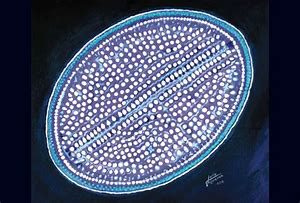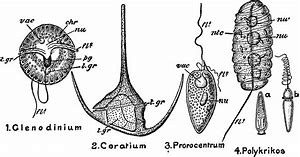In the last article, we discussed what phytoplankton are, what their needs were, and their importance to marine life throughout the Gulf and coastal estuaries. In this article, we will discuss the different types of phytoplankton found in our waters.

Image: Florida International University
Marine scientists interested in the diversity and abundance of phytoplankton will typically sample using a plankton net. There are a variety of different shapes and sizes of these nets, but the basic design would be funnel shaped with a sample jar attached at the small end of the funnel. The plankton net would be towed behind the research vessel at varying depths for a set period of time. All plankton collected would be analyzed via a microscope. According to the text Identifying Marine Phytoplankton (1997) there are at least 14,000 species of phytoplankton and some suggest as many as 120,000. Most of these, 12,000-100,000, are diatoms, one of five classes of marine phytoplankton. The majority of the phytoplankton fall into one of two class, the diatoms and the dinoflagellates.
Diatoms are typically single celled algae encased in a clear silica shell called a frustule. The frustule can come in a variety of shapes, with or without spines, and many resemble snowflakes – their quite beautiful. They are found in the bay and Gulf in great numbers, as many as 40,000,000 cells / cup of seawater. They are the dominate phytoplankton in colder waters and are most abundant near upwellings. These are the “grasses of the sea” and the base of many marine food webs. When diatoms die, their silica shells sink to the seafloor forming layers of diatomaceous earth, which is used in filters for aquariums and oxygen mask in hospitals.
Dinoflagellates differ from diatoms in that they produce two flagella, small hair-like projections from the algae that are used for generating water currents and movement. Their shells are not silica but layers of membranes and are called thecas. Some membranes are empty and others contain different types of polysaccharides. Dinoflagellates are more abundant than diatoms in warmer waters. There are about 2000 species of them. One type, Noctiluca, are responsible for what locals call “phosphorus” or bioluminescence. These dinoflagellates produce a blue-ish light when disturbed. Many see this when walking the beach at night. Their footprints glow for a few seconds. At night, boaters can see this as their prop wash turns the dinoflagellates in the water column. The bioluminescence is more pronounced in the warm summer months and is believed to be defense against predation. The light is referred to as “cool” light in that the majority of the energy is used in producing light, not lost as heat as with typical incandescent bulbs – hence the birth of the LED light industry.

Image: University of South Florida
Several dinoflagellates produce toxins as a defense. Some generate what we call red tides. In the Gulf of Mexico, Karenia brevis is the species most responsible for red tide. Red tides typical form offshore and are blown into coastal areas via wind and currents. They are common off the coast of southwest Florida but occur occasionally in the panhandle. Many local red tides are actually formed in southwest Florida and pushed northward via currents. Red tides are known to kill marine mammals and fish, as well as closing areas for shellfish harvesting.
Like true plants, phytoplankton conduct photosynthesis. Between the diatoms and dinoflagellates, 50% of the planet’s oxygen is produced. These are truly important players in the ecology of both the open Gulf and local bays.
References
Annett, A.L., D.S. Carson, X. Crosta, A. Clarke, R.S. Ganeshram. 2010. Seasonal Progression of Diatom
Assemblages in Surface Waters of Ryder Bay, Antarctica. Polar Biology vol 33. Pp. 13-29.
Hasle, G.R., E.E. Syvertsen. 1997. Identifying Marine Phytoplankton. Academic Press Harcourt Brace and
Company. San Diego CA. edited by C.R. Tomas. Pp. 858.
Steidinger, K.A., K. Tangen. 1997. Identifying Marine Phytoplankton. Academic Press Harcourt Brace and
Company. San Diego CA. edited by C.R. Tomas. Pp. 858.
 1
1
